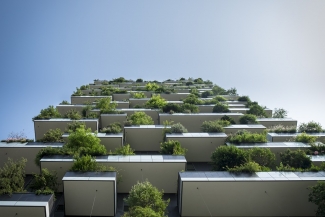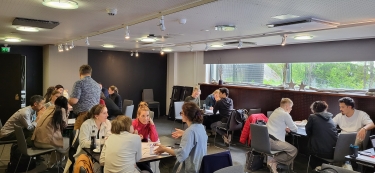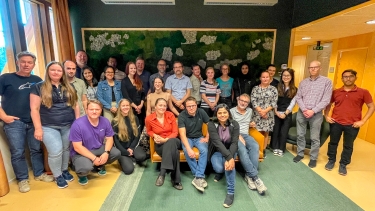Creating biocities

EFI Director Marc Palahi reflects on cities: they represent our greatest challenges but also our greatest opportunities for transforming our economic paradigm as a basis for a sustainable future.
Opening speech, 2018 Biocities Forum, 14.11.2018
Winston Churchill used to say that “we shape our buildings, then they shape us”.
We could extrapolate this idea to the level of cities because we built and shaped our first cities many thousands of years ago, and since then cities have shaped human civilization. In fact, the word civilization comes from the Latin word civis which means someone who lives in a city. However, even if cities are as old as human civilization, urbanization as a megatrend is rather new.
In fact, it was only during this century that for the first time, half of the world´s population are living in urban areas. Two hundred years ago for example, just before the Industrial era, only 7% of the world’s population lived in cities and towns. But since then, urbanization has accelerated. Every day our cities add around 200,000 more people and by 2050 more than two-thirds of the global population will live in urban areas. This also means that we still need to build 50% of the urban fabric needed by then. Considering that cities are our economic and innovation hubs, and also the major consumer of energy and resources, it is crucial that we reflect on why and how cities grow, and the consequences of such rapid urbanization for sustainable development.
In that context, first, it is important to remember that cities emerged because they are the most efficient system to self-organise ourselves in social networks that optimise our social interactions, the exchange of ideas and information, and support wealth creation based on the division of labour, specialization and innovation. All of that while minimising the transaction and infrastructure costs. Cities, therefore, are the most efficient systems to create social and economic capital. But what are the implications of such highly efficient systems for our natural capital and for our environment, which at the end are the basis for sustainable development?
It is also important to recognise the fundamental difference between how cities grow compared to biological systems. In biological systems, the amount of energy available for growth continuously decreases with increasing size until a point where growth stops. Biological systems/organisms grow sublinearly. With cities, on the contrary, the bigger the city, the more resources can be allocated for its socio-economic growth, and the faster it grows. The bigger the city, the more the average individual systematically owns, produces and consumes in terms of goods, resources, ideas (and by the way the faster it walks). So cities grow superlinearly with increasing returns to scale, provided the energy and resources are available.
This explains why urbanization did not accelerate until the Industrial Revolution started, which provided access to massive and affordable fossil energy and materials. This is why England, the first country to industrialise, was also the first to reach 50% of urban population in 1850, while in the USA that happened only 60 years later. This also explains why at a global level we only reached 50% of urban population this century, after experiencing the greatest global economic acceleration ever taking place in the last 30 years. In this period of time, the urban global population has doubled but the global GDP and the global middle class have tripled. Clearly, economic growth and urbanization mutually accelerate each other. The problem is that also entropy accelerates, the environmental problems related to a fossil-based economy accelerate.
After 200 years of such unprecedented urbanization and economic growth based on a fossil-based economy, we have arrived at a tipping point. Our urbanized world has become too big for our planet. This is clearly exemplified by climate change, biodiversity loss and the degradation of our natural resources. Having arrived at this tipping point we should remember the words of Albert Einstein who said that “we cannot solve our current problems with the same thinking we had when we created them”.
This is exactly what we need now, a new way of thinking as basis for a new economic paradigm for our urbanized world. A paradigm where cities, which are our economic and innovation hubs, take the lead in rethinking our economy to ensure it prospers within the renewable boundaries of our planet. A paradigm based on a new and synergistic relationship between economy and biology, and rural and urban areas in order to develop a circular bioeconomy capable of replacing the existing linear and fossil-based economy.
Cities need to lead the change, not only in replacing fossil energy by renewable energy but also in taking the lead in replacing non-renewable materials like plastics, steel or concrete by renewable biobased materials, replacing grey infrastructures by green ones.
Let me give you a concrete example: in Europe the use and construction of buildings represents 35% of the carbon emissions, 40% of energy consumption and 50% of all materials used. This is partly explained because two non-renewable materials dominate our urban infrastructures: steel and concrete which result in high carbon emissions. But replacing them by using wood in construction would reduce substantially the carbon footprint, because wood is the only significant construction material that is renewable and can be grown sustainably. Using wood is one of the most cost-effective ways to remove carbon dioxide from the atmosphere and store it for long periods of time.
Cities using wood in construction become carbon capture and storage infrastructures. In addition, urban forests and the strategic placements of trees around buildings, decrease the energy consumption in buildings for heating and cooling. They also reduce the increasing problem of the urban heat island effect. So wood, trees and forests are called to be the backbone of climate smart cities: Biocities.
Cities represent the good, the bad and the ugly of our world. They have a dual nature, represent our greatest challenges but also our greatest opportunities for transforming our economic paradigm as a basis for a sustainable future.
I believe that the biologization of cities is a pre-requisite to ensure that our urbanized world prospers in harmony with nature.


